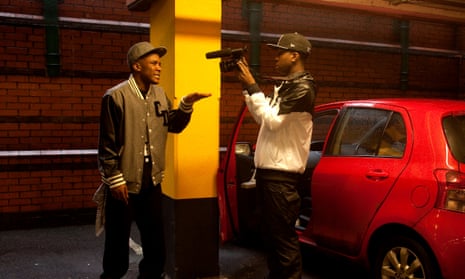The first video uploaded to music platform SBTV – 10 years ago this week – featured MCs Soul and Slides. The footage shows a few people shouting out “Smokey Barz” (founder Jamal Edwards’ early MC moniker which is where the channel gets its name) before two rappers go bar for bar. Adding to its off-the-cuff, DIY aesthetic, it was filmed during a college excursion. “I was at Cadbury’s chocolate factory in Birmingham on a college trip and I filmed them,” says Edwards. “I’m still quite proud of it”.
The video is still on his SBTV channel, which now hosts more than 10,000 videos, has amassed millions of views, and has helped launch the careers of countless UK underground artists. The channel has come a long way over the past decade, and so has Edwards, the 26-year-old west Londoner, deemed an “amateur film-maker turned multimillionaire” by the BBC and given an MBE in 2014. His story is now well-told within the scene: as a teenager he received a video camera from his mum for Christmas, used it to start shooting grime videos on his estate and in a few short years turned a hobby into a music platform now worth an estimated £8m. Penetrating the DVD culture of existing music series created by Risky Roadz, Lord of the Mics, and Practice Hours, SBTV marked the arrival of a YouTube generation who consumed music content online. Before Zoella had sold her first product or PewDiePie had narrated his first Call of Duty, Edwards was at the frontline, unboxing talent on his estate.
“I think in the early days people didn’t take me as seriously,” says Edwards. “I was working at Topman, doing a moving image course at college and just wanted creative control over something. So I just filmed what was around me.”
SBTV wasn’t just a place to see MCs and rappers on an easily accessible and free medium. While X Factor contestants and the Kaiser Chiefs filled mainstream TV coverage in the mid noughties, SBTV made the caricature-packed world of grime visible. There were other platforms at the time – such as GRM Daily, which hosted similar content – but it was via SBTV that some of the most iconic video moments appeared: Skepta’s In the Country Wiley diss, for example, saw the MC spit over a Blur sample while standing outside Wiley’s (fake) house in the country. These kinds of comic videos debunked the rhetoric at the time, that grime was a menacing pool populated with angry MCs in hoodies who incited violence. In reality, the artists and their fans were laughing about “spitting in your mouthwash” (Professor Green) “not picking up a semi / But I’ll pick up the mic whenever you’re ready,” (JME) and standing in the snow talking about peas and mash (G Fresh).
SBTV also gave the scene ‘Fresh’ or F64s – a freestyle consisting of 64 bars that MCs and rappers were challenged to spit in one take for the camera. It was an early example of “appointment viewing” – played at 5pm on a Sunday eveningit would, according to Edwards “trend on Twitter every week”. It was this kind of organic popularity that proved that the urban music scene had an audience – despite it not filtering into the mainstream – and that fans of grime in particular were loyal.
“If you got on SBTV back then, it was a milestone. It was the place,” says MC Yungen who recorded an F64 in 2012 which went on to be one of the most viewed on the site. “Twitter wasn’t really popping at this time, so me and Jamal Facebook messaged,” he says. “He agreed to film a warm up session [a place for brand new artists] and I was like: ‘Sick!’ It was just before my 19th birthday and I went to record it on the side road of his house with just him. It took 20 minutes and then after he was like: ‘Yeah I’ll put it out next week’”.
“Six months later we did the F64 and he had a proper team. Everything changed – it had all these skill shots and side angles on it. My video got 100,000 views so I basically felt like I’d made it.”
Artists like Yungen are good indicators of how much the music industry has changed. In 2007, the mainstream industry had not quite caught up to black British music’s shifting sound, and successful artists away from this scene tended to follow a traditional path that required investment and mainstream backing. Key to Edwards’ success was that he was harnessing the powers of YouTube before the industry realised it was such a haven for creativity. When it came to underground artists, SBTV could play a crucial part in an artist’s trajectory. Instead of waiting to get signed by a label or for radio to create the hype, artists could put their freestyle on SBTV, get a manager and a million views on YouTube, then leverage that to get a record deal. In 2017 – with cases such as Stormzy or Boy Better Know – major label backing is no longer essential.
“Jamal was literally picking talent up from the street,” Yungen says. “But there just wasn’t as many eyes looking to the streets back then.”
Austin Daboh, senior content editor at Spotify, recognises how crucial SBTV has been to the current boom of urban music in the mainstream. Stars that were once underground are now ubiquitous: Stormzy and Nines have Top 10 albums, Skepta won the 2016 Mercury prize and Sadiq Khan posed with Wiley and a host of grime MCs at the NME awards.
“I think SBTV, alongside Link Up and GRMDaily, has done a brilliant job of going places where mainstream media traditionally haven’t gone,” says Daboh. “SBTV was integral to Ed Sheeran and Devlin.”
Part of the thrill of this music community was that it produced talent untarnished by the bureaucracy and commercial pressures of the industry. But now the gatekeepers of urban music culture are out of their bedrooms and estates, and into boardrooms and offices, can it still remain a democratic process?
“The streets are still the gatekeeper,” Daboh says. “It’s in prisons, barbers, chicken shops, it’s those places that young people congregate – they’re the ones who decide whether something is hot. We’re just a conduit of what’s going on in the street and the rest of the public.”
In 2017, the shine of SBTV is not as bright as it once was. It is now up against competitive digital platforms such as Boiler Room events, Instagram stories and Snapchat videos, but it remains a piece of music history. The story of SBTV shows the development of a channel which helped to launch the careers of some of the UK’s biggest stars. Edwards enabled and emboldened artists to make the case that they had a real following. He legitimised the voices of the streets, and was the kind of young person that left the group on a trip to shoot a lo-res, grainy recording of his college mates Soul and Slides, because he thought people should see them. That, beyond any of his smart technological choices or Ed Sheeran affiliations, will remain his legacy.








Comments (…)
Sign in or create your Guardian account to join the discussion